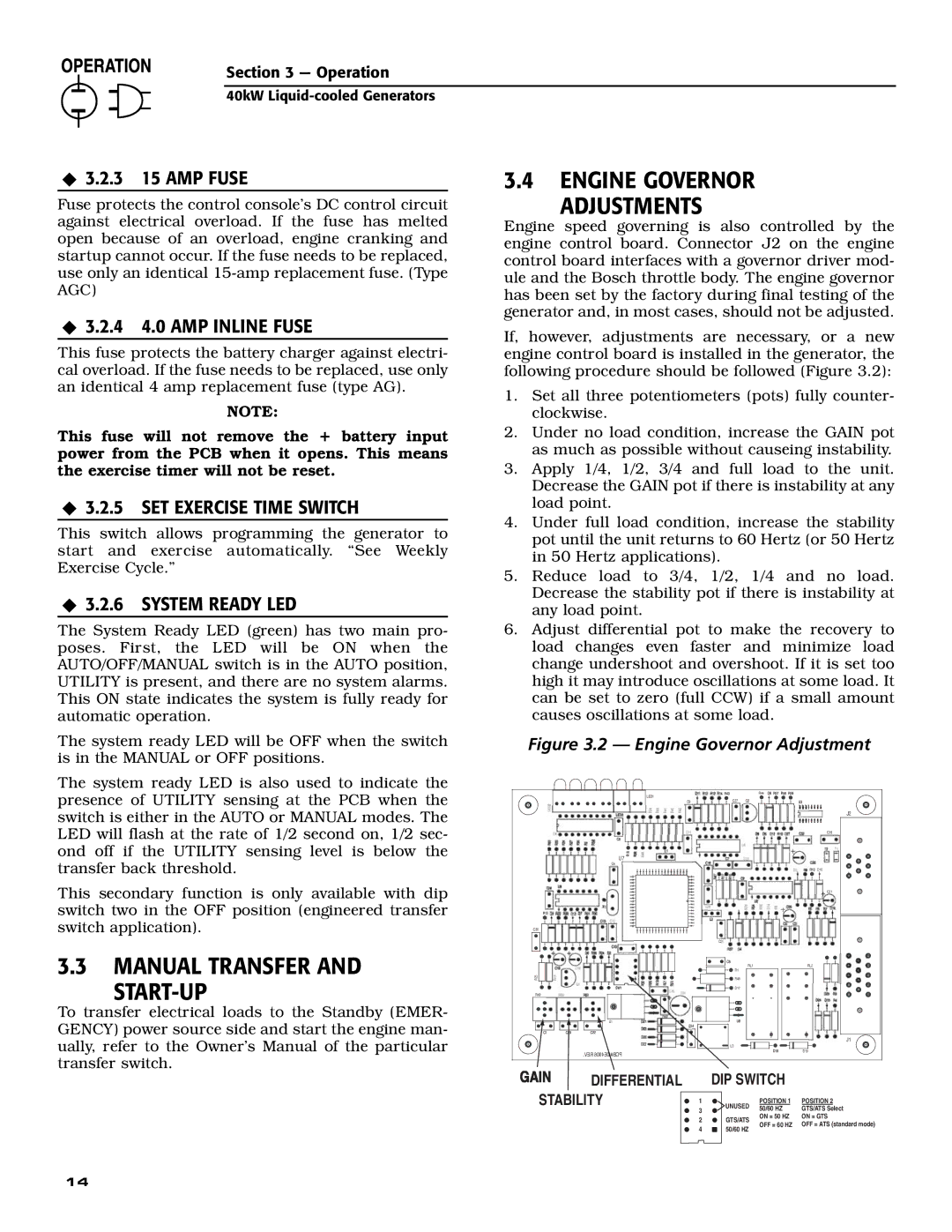
Section 3 — Operation
40kW
3.2.3 15 AMP FUSE
Fuse protects the control console’s DC control circuit against electrical overload. If the fuse has melted open because of an overload, engine cranking and startup cannot occur. If the fuse needs to be replaced, use only an identical
3.2.4 4.0 AMP INLINE FUSE
This fuse protects the battery charger against electri- cal overload. If the fuse needs to be replaced, use only an identical 4 amp replacement fuse (type AG).
NOTE:
This fuse will not remove the + battery input power from the PCB when it opens. This means the exercise timer will not be reset.
3.2.5 SET EXERCISE TIME SWITCH
This switch allows programming the generator to start and exercise automatically. “See Weekly Exercise Cycle.”
3.2.6 SYSTEM READY LED
The System Ready LED (green) has two main pro- poses. First, the LED will be ON when the AUTO/OFF/MANUAL switch is in the AUTO position, UTILITY is present, and there are no system alarms. This ON state indicates the system is fully ready for automatic operation.
The system ready LED will be OFF when the switch is in the MANUAL or OFF positions.
3.4ENGINE GOVERNOR
ADJUSTMENTS
Engine speed governing is also controlled by the engine control board. Connector J2 on the engine control board interfaces with a governor driver mod- ule and the Bosch throttle body. The engine governor has been set by the factory during final testing of the generator and, in most cases, should not be adjusted.
If, however, adjustments are necessary, or a new engine control board is installed in the generator, the following procedure should be followed (Figure 3.2):
1.Set all three potentiometers (pots) fully counter- clockwise.
2.Under no load condition, increase the GAIN pot as much as possible without causeing instability.
3.Apply 1/4, 1/2, 3/4 and full load to the unit. Decrease the GAIN pot if there is instability at any load point.
4.Under full load condition, increase the stability pot until the unit returns to 60 Hertz (or 50 Hertz in 50 Hertz applications).
5.Reduce load to 3/4, 1/2, 1/4 and no load. Decrease the stability pot if there is instability at any load point.
6.Adjust differential pot to make the recovery to load changes even faster and minimize load change undershoot and overshoot. If it is set too high it may introduce oscillations at some load. It can be set to zero (full CCW) if a small amount causes oscillations at some load.
Figure 3.2 — Engine Governor Adjustment
The system ready LED is also used to indicate the presence of UTILITY sensing at the PCB when the switch is either in the AUTO or MANUAL modes. The LED will flash at the rate of 1/2 second on, 1/2 sec- ond off if the UTILITY sensing level is below the transfer back threshold.
This secondary function is only available with dip switch two in the OFF position (engineered transfer switch application).
3.3MANUAL TRANSFER AND
START-UP
To transfer electrical loads to the Standby (EMER- GENCY) power source side and start the engine man- ually, refer to the Owner’s Manual of the particular transfer switch.
14
LED1
2
U7
C4
C30
R25
R49
U1
.REV | E4906 PCB# |
DIFFERENTIAL STABILITY
|
|
| R44 |
| |
C9 | C27 | Q2 |
|
| |
|
|
|
| J2 | |
|
|
|
| C26 | |
|
|
|
| D10 | |
|
|
|
| C21 | |
| C2 |
|
|
| |
|
| RL1 |
| RL2 | |
| R1 |
|
|
| |
| R48 |
|
|
| |
| D17 |
|
|
| |
|
|
|
| J1 | |
| L3 |
|
|
| |
|
|
|
| D19 | |
| DIP SWITCH |
| |||
1 | UNUSED | POSITION 1 | POSITION 2 | ||
3 | 50/60 HZ | GTS/ATS Select | |||
|
| ||||
2 | GTS/ATS | ON = 50 HZ | ON = GTS | ||
OFF = 60 HZ | OFF = ATS (standard mode) | ||||
4 | 50/60 HZ | ||||
|
| ||||
